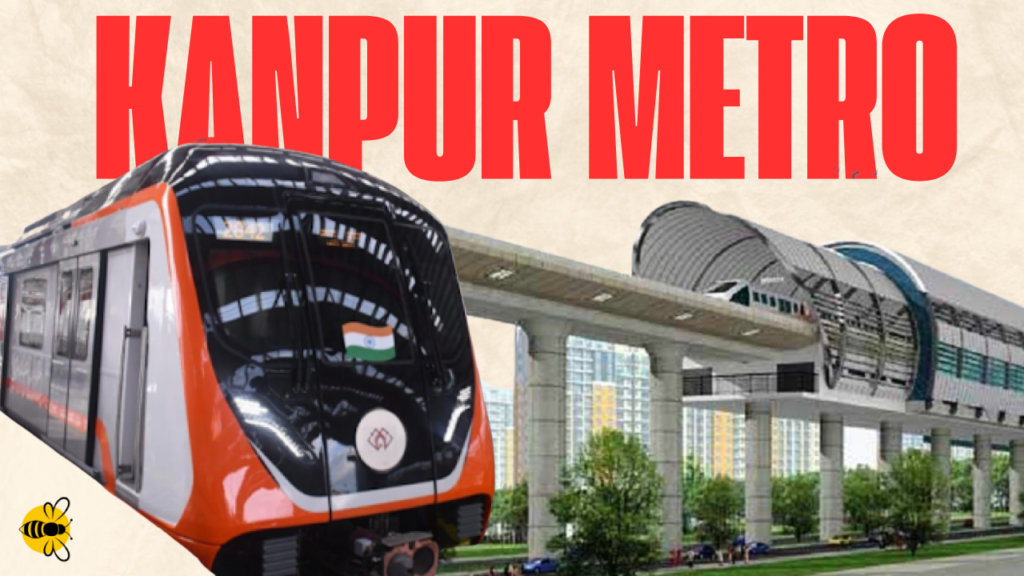The Kanpur Metro project stands as a transformative initiative aimed at revolutionizing urban transportation in Kanpur, Uttar Pradesh. Designed to alleviate traffic congestion, reduce pollution, and provide efficient mobility, the metro system is poised to significantly enhance the daily commute for residents and visitors alike. This article delves into the comprehensive details of the Kanpur Metro, exploring its background, project specifics, infrastructure, technological advancements, and anticipated impact on the city’s urban landscape.

Background and Inception
The concept of introducing a metro system in Kanpur emerged in response to escalating traffic woes, environmental concerns, and the necessity for a sustainable urban transit solution. Recognizing these challenges, urban planners and policymakers initiated discussions in 2016 to explore the feasibility of a mass rapid transit system. Following extensive studies and deliberations, the Detailed Project Report (DPR) was prepared by RITES and received approval from the state cabinet in March 2016. Subsequently, the Central Government’s Cabinet granted its approval in February 2019, marking a significant milestone in Uttar Pradesh’s infrastructure development.
Project Overview
The Kanpur Metro project encompasses the development of two primary corridors, meticulously planned to enhance connectivity across the city:
- Orange Line (Corridor 1): IIT Kanpur to Naubasta
- Length: 23.8 kilometers
- Stations: 21 (14 elevated and 7 underground)
- Route Highlights: This corridor traverses significant residential and commercial zones, including Kalyanpur, Rawatpur, Mall Road, Phool Bagh, and reaches up to Naubasta.
- Blue Line (Corridor 2): Agriculture University to Barra-8
- Length: 8.6 kilometers
- Stations: 8 (5 elevated and 3 underground)
- Route Highlights: Connecting the educational hub of Agriculture University to the residential area of Barra-8, this corridor aims to facilitate smooth transit for students and professionals alike. kanpur.upmetrorail.com
Infrastructure and Technological Features
The Kanpur Metro is designed with state-of-the-art infrastructure and incorporates advanced technological features to ensure safety, efficiency, and passenger comfort:
- Modern Rolling Stock: The trains are equipped to accommodate approximately 975 passengers per trip, featuring energy-efficient systems like regenerative braking to optimize power consumption. dwello.in
- Station Amenities: Stations are designed with passenger convenience in mind, offering facilities such as automated ticketing systems, clear signage, information kiosks, and provisions for retail outlets.
- Digital Integration: The metro system integrates digital technologies to enhance the commuting experience, including real-time updates, automated operations, and seamless connectivity with existing transportation networks.
Project Timeline and Financial Aspects
The project’s foundation stone was laid by Prime Minister Narendra Modi on March 8, 2019, signifying the commencement of construction activities. The Uttar Pradesh Metro Rail Corporation (UPMRC) is the executing agency responsible for overseeing the project’s development and eventual operation. The total estimated cost of the Kanpur Metro project is approximately INR 11,076.48 crores, with financial backing from both the central and state governments, as well as a significant loan from the European Investment Bank (EIB), which invested €650 million to support the construction of Kanpur’s first city metro line.
Current Status and Future Prospects
As of December 28, 2021, the Kanpur Metro commenced operations on an 8.7-kilometer stretch of the Orange Line, marking a significant milestone in the city’s public transportation landscape. This initial phase connects IIT Kanpur to Moti Jheel, covering nine stations and providing residents with a modern and efficient commuting option.
The project is progressing in phases, with the entire network expected to span 32.38 kilometers upon completion by the end of 2026. The phased approach allows for systematic development, ensuring that each segment meets the required standards of safety and efficiency before becoming operational.
Anticipated Benefits
The Kanpur Metro is poised to deliver numerous benefits that extend beyond mere transportation:
- Reduction in Traffic Congestion: By providing a reliable alternative to private vehicles, the metro aims to decongest the city’s roads, leading to smoother traffic flow.
- Environmental Impact: The shift from road-based transport to a mass rapid transit system is expected to reduce vehicular emissions, contributing to improved air quality and a healthier environment.
- Economic Growth: Enhanced connectivity can stimulate economic activities by attracting investments, boosting tourism, and creating employment opportunities during both construction and operational phases.
- Social Inclusion: The metro system offers an affordable and accessible mode of transport, benefiting a diverse demographic, including students, professionals, and the underprivileged, thereby promoting social equity.
Challenges and Mitigation Strategies
While the Kanpur Metro project promises substantial advantages, it also faces several challenges:
- Land Acquisition: Securing land for construction, especially in densely populated areas, poses significant hurdles. To mitigate this, the authorities have engaged in transparent negotiations and offered fair compensation to affected parties.
- Technical Complexities: Constructing underground sections requires advanced engineering solutions to navigate existing utilities and infrastructure. Collaboration with experienced engineering firms and the adoption of cutting-edge tunneling technologies have been employed to address these challenges.
Financial Management:
Managing project costs, securing timely funding, and ensuring efficient budget utilization remain critical challenges. However, with financial backing from the European Investment Bank (EIB), central and state government allocations, and private investments, the project is being executed within a well-structured financial framework. Transparency in financial dealings and periodic audits are ensuring accountability.
Public Awareness and Behavioral Change:
A shift from private vehicle usage to public transportation requires a change in commuter behavior. The authorities are running awareness campaigns to educate people about the benefits of the metro, including cost savings, time efficiency, and environmental advantages.
Comparative Analysis: Kanpur Metro vs. Other Indian Metros
To understand Kanpur Metro’s significance, here’s a comparison with other metro projects in India:
| Feature | Kanpur Metro | Lucknow Metro | Delhi Metro | Mumbai Metro |
|---|---|---|---|---|
| Total Length (Planned) | 32.38 km | 22.87 km | 391 km | 356 km |
| No. of Corridors | 2 | 2 | 10+ | 14+ |
| Operational Length (as of 2025) | 8.7 km | 22.87 km | 390+ km | 50+ km |
| Project Cost (₹ Crore) | ~11,076 | ~6,880 | ~70,000 | ~1,50,000 |
| Year of Inauguration | 2021 (Phase 1) | 2017 | 2002 | 2014 (Phase 1) |
| Rolling Stock Manufacturer | Bombardier (Alstom) | Alstom | Hyundai Rotem, Bombardier | Alstom, BEML |
| Funding Support | EIB, Govt. of India, State Govt. | EIB, Govt. of India, State Govt. | JICA, Govt. of India | ADB, Govt. of India |
Future Expansion Plans
The Kanpur Metro project is envisioned as a continuously evolving network that can be expanded based on the city’s needs. Future plans may include:
- Extensions of the Orange Line and Blue Line to cover additional areas.
- Integration with Bus Rapid Transit (BRT) System to enhance first-mile and last-mile connectivity.
- Development of new corridors connecting industrial hubs, educational institutions, and suburban regions.
Comparison with Other Metro Systems
To understand how Kanpur Metro stands in comparison to other metro projects in India, here’s a quick comparison table:
| Feature | Kanpur Metro | Lucknow Metro | Delhi Metro | Mumbai Metro |
|---|---|---|---|---|
| Total Length (Planned) | 32.38 km | 22.87 km | 348 km | 356 km |
| Operational Lines | 1 (Orange Line partial) | 2 (Red & Blue) | Multiple | 2 (More under construction) |
| Number of Stations | 29 | 21 | 253 | 42 |
| Technology Used | Driverless, Modern Rolling Stock | Driver-assisted | Driverless & Automated Systems | Advanced Hybrid Systems |
| Ticketing System | Contactless Smart Cards & QR Tickets | Contactless | Smart Cards, Tokens, Mobile Payments | Digital Wallet Integration |
From this table, we can see that while Kanpur Metro is still in its early stages, it is designed with cutting-edge features and is expected to expand further in the coming years.
Challenges and Strategies for Overcoming Them
Despite its ambitious vision, the Kanpur Metro faces several roadblocks. Some key challenges include:
1. Funding and Budget Constraints
- While the project has received a loan from the European Investment Bank (€650 million) and funding from the Central and State Governments, cost overruns remain a risk.
- Solution: Authorities are exploring public-private partnerships (PPP) and revenue generation from advertisements and commercial spaces at metro stations.
2. Land Acquisition and Legal Disputes
- Some areas faced opposition from local residents and businesses due to concerns over displacement and environmental impact.
- Solution: The government ensured fair compensation and rehabilitation for affected individuals.
3. Integration with Existing Transport
- Kanpur has a strong presence of buses, auto-rickshaws, and cycle-rickshaws, creating a challenge in integrating these with the metro system.
- Solution: Feeder bus services, improved pedestrian access, and last-mile connectivity initiatives are being planned.
4. Public Awareness and Adoption
- Many people are still accustomed to road transport and hesitant about shifting to metro travel.
- Solution: Promotional campaigns and metro awareness programs are being conducted to educate citizens on the benefits of the new system.
Future Expansion and Potential Developments
The Kanpur Metro is designed to grow beyond its initial network. Potential future developments include:
- Third Corridor: Discussions are underway for a third corridor, which could connect other industrial and residential hubs.
- Green Initiatives: Plans to integrate solar energy into station power supply and introduce electric feeder buses.
- Smart City Synergy: Integration of metro services with Kanpur’s broader Smart City initiatives for better urban planning.
Impact on Kanpur’s Economy and Environment
1. Economic Growth:
- Increased connectivity will boost commercial activity, encourage new businesses, and raise property values around metro stations.
- Employment opportunities will rise, both in the metro sector and related services like retail and real estate.
2. Environmental Benefits:
- Reduced dependency on fossil-fuel-based transport will lead to lower CO2 emissions.
- Noise pollution will decrease, making urban areas more livable.
3. Social Benefits:
- Affordable and time-efficient commuting options for lower-income groups.
- Greater mobility for students and working professionals, leading to higher productivity.
Final Thoughts: A Game-Changer for Kanpur’s Future
The Kanpur Metro is more than just a transportation project—it’s a step towards making Kanpur a modern, efficient, and livable city. As the metro expands and integrates into daily life, it will redefine urban mobility and set an example for other emerging metro projects in India.
With strong government backing, international investment, and growing public enthusiasm, the Kanpur Metro is set to become one of the most successful transit projects in the country.
As more stations become operational and new corridors are planned, Kanpur will witness a true urban revolution—one that enhances convenience, reduces congestion, and propels the city into the future.




0 Comments